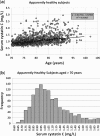Estimating glomerular filtration rate for the full age spectrum from serum creatinine and cystatin C
- PMID: 28089986
- PMCID: PMC5837496
- DOI: 10.1093/ndt/gfw425
Estimating glomerular filtration rate for the full age spectrum from serum creatinine and cystatin C
Abstract
Background: We recently published and validated the new serum creatinine (Scr)-based full-age-spectrum equation (FAS crea ) for estimating the glomerular filtration rate (GFR) for healthy and kidney-diseased subjects of all ages. The equation was based on the concept of normalized Scr and shows equivalent to superior prediction performance to the currently recommended equations for children, adolescents, adults and older adults.
Methods: Based on an evaluation of the serum cystatin C (ScysC) distribution, we defined normalization constants for ScysC ( Q cysC = 0.82 mg/L for ages <70 years and Q cysC = 0.95 mg/L for ages ≥70 years). By replacing Scr/ Q crea in the FAS crea equation with ScysC/ Q cysC , or with the average of both normalized biomarkers, we obtained new ScysC-based (FAS cysC ) and combined Scr-/ScysC-based FAS equations (FAS combi ). To validate the new FAS cysC and FAS combi we collected data on measured GFR, Scr, ScysC, age, gender, height and weight from 11 different cohorts including n = 6132 unique white subjects (368 children, aged ≤18 years, 4295 adults and 1469 older adults, aged ≥70 years).
Results: In children and adolescents, the new FAS cysC equation showed significantly better performance [percentage of patients within 30% of mGFR (P30) = 86.1%] than the Caucasian Asian Paediatric Adult Cohort equation (P30 = 76.6%; P < 0.0001), or the ScysC-based Schwartz equation (P30 = 68.8%; P < 0.0001) and the FAS combi equation outperformed all equations with P30 = 92.1% (P < 0.0001). In adults, the FAS cysC equation (P30 = 82.6%) performed equally as well as the Chronic Kidney Disease Epidemiology Collaboration equation (CKD-EPI cysC ) (P30 = 80.4%) and the FAS combi equation (P30 = 89.9%) was also equal to the combined CKD-EPI equation (P30 = 88.2%). In older adults, FAS cysC was superior (P30 = 88.2%) to CKD-EPI cysC (P30 = 84.4%; P < 0.0001) and the FAS combi equation (P30 = 91.2%) showed significantly higher performance than the combined CKD-EPI equation (P30 = 85.6%) (P < 0.0001).
Conclusion: The FAS equation is not only applicable to all ages, but also for all recommended renal biomarkers and their combinations.
Keywords: all ages; all renal biomarkers; combined FAS equation; cystatin C; serum creatinine.
© The Author 2017. Published by Oxford University Press on behalf of ERA-EDTA. All rights reserved.
Figures



Comment in
-
Glomerular filtration rate estimating equations: practical, yes, but can they replace measured glomerular filtration rate?Nephrol Dial Transplant. 2017 Mar 1;32(3):405-407. doi: 10.1093/ndt/gfx006. Nephrol Dial Transplant. 2017. PMID: 28339825 No abstract available.
Similar articles
-
Improved glomerular filtration rate estimation using new equations combined with standardized cystatin C and creatinine in Chinese adult chronic kidney disease patients.Clin Biochem. 2014 Sep;47(13-14):1220-6. doi: 10.1016/j.clinbiochem.2014.05.060. Epub 2014 Jun 2. Clin Biochem. 2014. PMID: 24886770
-
Comparison of estimated glomerular filtration rates in Chinese patients with chronic kidney disease among serum creatinine-, cystatin-C- and creatinine-cystatin-C-based equations: A retrospective cross-sectional study.Clin Chim Acta. 2020 Jun;505:34-42. doi: 10.1016/j.cca.2020.01.033. Epub 2020 Feb 3. Clin Chim Acta. 2020. PMID: 32027887
-
An estimated glomerular filtration rate equation for the full age spectrum.Nephrol Dial Transplant. 2016 May;31(5):798-806. doi: 10.1093/ndt/gfv454. Epub 2016 Feb 29. Nephrol Dial Transplant. 2016. PMID: 26932693 Free PMC article.
-
Calibration and precision of serum creatinine and plasma cystatin C measurement: impact on the estimation of glomerular filtration rate.J Nephrol. 2014 Oct;27(5):467-75. doi: 10.1007/s40620-014-0087-7. Epub 2014 Apr 8. J Nephrol. 2014. PMID: 24711159 Review.
-
Estimating renal function in children: a new GFR-model based on serum cystatin C and body cell mass.Dan Med J. 2012 Jul;59(7):B4486. Dan Med J. 2012. PMID: 22759853 Review.
Cited by
-
Improving glomerular filtration rate estimation by semi-supervised learning: a development and external validation study.Int Urol Nephrol. 2021 Aug;53(8):1649-1658. doi: 10.1007/s11255-020-02771-w. Epub 2021 Mar 12. Int Urol Nephrol. 2021. PMID: 33710531
-
A Validation Study on eGFR Equations in Chinese Patients With Diabetic or Non-diabetic CKD.Front Endocrinol (Lausanne). 2019 Aug 26;10:581. doi: 10.3389/fendo.2019.00581. eCollection 2019. Front Endocrinol (Lausanne). 2019. PMID: 31507533 Free PMC article.
-
Chronic kidney disease attenuates the plasma metabolome response to insulin.JCI Insight. 2018 Aug 23;3(16):e122219. doi: 10.1172/jci.insight.122219. eCollection 2018 Aug 23. JCI Insight. 2018. PMID: 30135309 Free PMC article. Clinical Trial.
-
Low agreement between various eGFR formulae in pediatric and young adult ADPKD patients.Pediatr Nephrol. 2023 Sep;38(9):3043-3053. doi: 10.1007/s00467-023-05926-w. Epub 2023 Mar 20. Pediatr Nephrol. 2023. PMID: 36939917
-
Comparison of estimated glomerular filtration rate equations based on serum creatinine-, cystatin C- and creatinine-cystatin C in elderly Chinese patients.Int Urol Nephrol. 2023 Apr;55(4):943-952. doi: 10.1007/s11255-022-03370-7. Epub 2022 Sep 28. Int Urol Nephrol. 2023. PMID: 36169900
References
-
- Delanaye P, Pottel H, Botev R.. Con: should we abandon the use of the MDRD equation in favour of the CKD-EPI equation? Nephrol Dial Transplant 2013; 28: 1396–1403 - PubMed
-
- Pottel H, Hoste L, Yayo E. et al. Glomerular filtration rate in healthy living potential kidney donors: a meta-analysis supporting the construction of the full age spectrum (FAS) equation. Nephron Clin Pract 2016; Nephron 2016 Oct 21. [Epub ahead of print] DOI:10.1159/000450893 - PubMed
-
- Grubb A, Blirup-Jensen S, Lindström V. et al. First certified reference material for cystatin C in human serum ERM-DA471/IFCC. Clin Chem Lab Med 2010; 48: 1619–1621 - PubMed
MeSH terms
Substances
Grants and funding
LinkOut - more resources
Full Text Sources
Other Literature Sources
Medical
Research Materials
Miscellaneous

